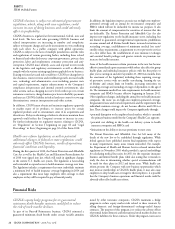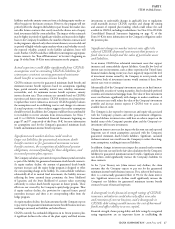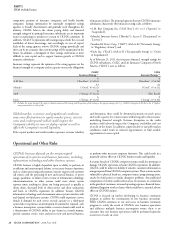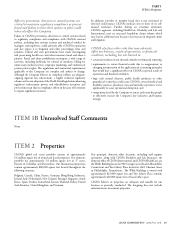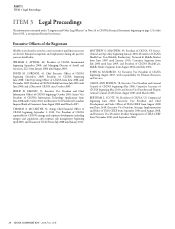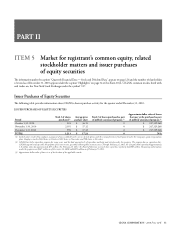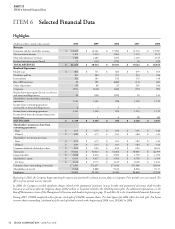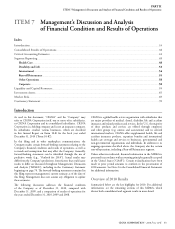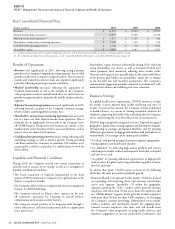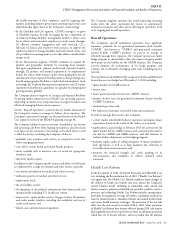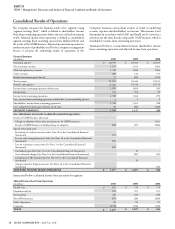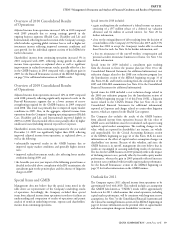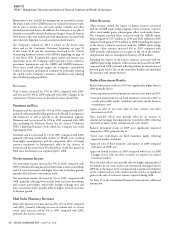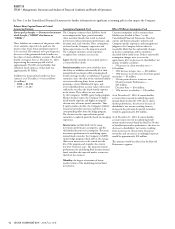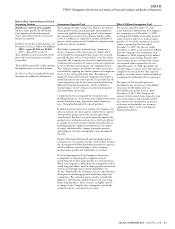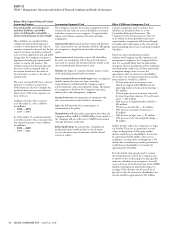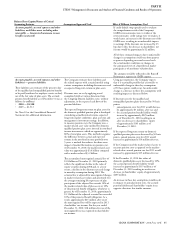Cigna 2010 Annual Report Download - page 56
Download and view the complete annual report
Please find page 56 of the 2010 Cigna annual report below. You can navigate through the pages in the report by either clicking on the pages listed below, or by using the keyword search tool below to find specific information within the annual report.CIGNA CORPORATION 2010 Form 10K
36
PART II
ITEM 7 Management’s Discussion and Analysis of Financial Condition and Results of Operations
impact of Health Care Reform could have a material impact on the
Company’s results of operations. e Company is evaluating potential
business opportunities resulting from Health Care Reform that will
enable it to leverage the strengths and capabilities of its broad health and
wellness portfolio.
Health Care Reform will require the assessment of fees and excise
taxes on health services companies such as CIGNA and others in the
health care industry to help fund the additional insurance benefi ts and
coverages provided by this legislation. e amount which the Company
will be required to pay starting in 2013 and 2014 for these fees and
excise taxes will result in charges to the Company’s fi nancial statements
in future periods. In addition, since these fees and excise taxes will not be
tax deductible, the Company’s eff ective tax rate is expected to increase in
future periods. However, the Company is unable to estimate the amount
of these fees and excise taxes or the increase in the eff ective tax rate
because guidance for the calculation has not been fi nalized.
Health Care Reform also changes certain tax laws which aff ected the
Company’s 2010 fi nancial statements. Although these provisions
do not become eff ective until 2013, they are expected to limit the
tax deductibility of certain future retiree benefi t and compensation-
related payments earned after 2009. e Company recorded after-tax
charges of approximately $10 million for the twelve months ended
December 31, 2010 related to these changes. e Company will
continue to evaluate the impact of these tax laws as further guidance is
made available.
During 2010, the Company incurred total after-tax costs of approximately
$25 million related to Health Care Reform comprised of:
•$10 million of additional income tax related to the impact of the tax
law changes as described previously, and
•$15 million of costs related to building the infrastructure necessary
to comply with the provisions of Health Care Reform which were
eff ective in 2010 and 2011 of which $7 million were incremental costs.
e remaining $8 million refl ected the estimated cost of internal staff
redeployed to work on Health Care Reform initiatives.
Many provisions of Health Care Reform are not eff ective until future
years and the Company will continue to implement these provisions.
On January 1, 2011, the minimum loss ratio became eff ective and
will require payment of premium rebates beginning in 2012 to
employers and customers covered under the Company’s comprehensive
medical insurance if certain minimum medical loss ratios are not met.
Management estimates charges for rebates to approximate $25 million
after-tax for the year ending December 31, 2011. is estimate followed
the most current regulatory guidance for the calculation of rebates and
was developed using assumptions about the amount and distribution for
claim experience, enrollment and premiums earned by state and market
segment. Actual rebates could diff er substantially from management’s
estimates if actual experience diff ers from the assumptions.
Management is currently unable to estimate the full impact of Health
Care Reform on the Company’s future results of operations, and
its fi nancial condition and liquidity due to uncertainties related to
interpretation, implementation and timing of its many provisions. It is
possible; however, that this impact could be material to future results of
operations. Management, through its internal task force, continues to
closely monitor implementation of the law, report on the Company’s
compliance with Health Care Reform, actively engage with regulators to
assist with the ongoing conversion of legislation to regulation and assess
potential opportunities arising from Health Care Reform.
Acquisitions and Dispositions
In line with its growth strategy, the Company has strengthened its
market position and reduced balance sheet exposures through the
following acquisition and disposition transactions.
Reinsurance of Run-off Workers’ Compensation and
Personal Accident Business
On December 31, 2010, the Company essentially exited from its
workers’ compensation and personal accident reinsurance business
by purchasing retrocessional coverage from a Bermuda subsidiary
of Enstar Group Limited and transferring administration of this
business to the reinsurer. See Note 3 to the Consolidated Financial
Statements for additional information.
Sale of Workers’ Compensation and Case Management
Business
On December 1, 2010 the Company completed the sale of its
workers’ compensation and case management business to GENEX
Holdings, Inc. e Company recognized an after-tax gain on sale
of $11 million ($18 million before tax) which was reported in other
revenues in the Disability and Life segment. See Note 3 to the
Consolidated Financial Statements for additional information.
Acquisition of Vanbreda International
On August 31, 2010, the Company acquired 100% of the voting
stock of Vanbreda International NV (“Vanbreda International”),
based in Antwerp, Belgium for a cash purchase price of $412 million.
See Note 3 to the Consolidated Financial Statements for additional
information about the acquisition of Vanbreda International.
Acquisition of Great-West Healthcare
On April 1, 2008, the Company acquired the Health care division
of Great-West Life and Annuity, Inc. (“Great-West Healthcare”).
See Note 3 to the Consolidated Financial Statements for additional
information.
Initiatives to Lower Operating Expenses
As part of its strategy, the Company has undertaken several initiatives
to realign its organization and consolidate support functions in an
eff ort to increase effi ciency and responsiveness to customers and to
reduce costs.
During 2008 and 2009, the Company conducted a comprehensive
review to reduce certain operating expenses of its ongoing businesses
(“cost reduction program”). As a result, the Company recognized
severance-related and real estate charges in other operating expenses.
Severance charges in 2008 and 2009 resulted from reductions of
approximately 2,350 positions in the Company’s workforce. Cost
reduction activities associated with these charges are substantially
complete as of December 31, 2010 with severance expected to
be paid by the end of the second quarter of 2011. In 2010, the
Company recorded an incremental pre-tax charge of $6 million
($4 million after-tax) to refl ect actual severance experience diff ering
from prior assumptions.


